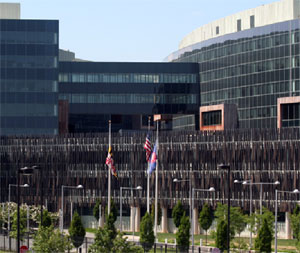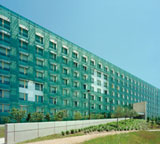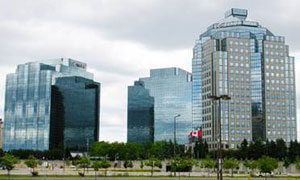The state of Minnesota and the city of Oakland, California are the latest governments to pass legislation that mandates bird-friendly building designs.
They join San Francisco – which passed "Standards for Bird Safe Buildings" in 2011 – along with several municipalities in the Chicago area. The city of Chicago has produced voluntary guidelines.
National legislation has been introduced in the House by Illinois representative Mike Quigley. It calls for all public buildings, whether renovated, constructed or acquired to incorporate bird-friendly designs and materials, as well as modify existing buildings to meet these goals.
As many as one billion birds die each year colliding with buildings, one of the leading causes of bird mortality in the US.
Glass-sided buildings have been popular for decades and as designers strive for more energy-efficient buildings, they tend to use more glass to bring in daylight. Birds are confused by the light that reflects off glass because they see the reflection of sky and trees. Since green buildings often emphasize native landscaping, that attracts birds to the site.
"There is a growing awareness of and alarm about the very significant bird mortality that is occurring across the US as a result of bird collisions with buildings," says Dr. Christine Sheppard of American Bird Conservancy(ABC). "As ABC and other groups have raised awareness of the problem, we are seeing increasing interest among local governments, architects, and developers regarding bird-friendly building design and how to foster it through mandatory and voluntary regulatory processes."
Modifying building designs for birds doesn’t have to be difficult. Basically it revolves around creating facades that have "visual noise" to help birds distinguish them from inviting skies – making glass less reflective and more textured and/or opaque.
Lighting is another important area that can be address through simple adjustments, such as turning off interior lights at night and making sure exterior lights aren’t angled up toward the sky.
The photo below shows the sunshade used on the U.S. Census Complex in Maryland. It controls heat and light, while making the glass safe for birds. Photo by Esther Langan.

Here’s another approach:

Minnesota is using LEED’s "Reducing Bird Collisions" program, which also earns a LEED credit, and Oakland’s law is similar to San Francisco.
Minnesota’s guidelines address all phases of design and construction, as well as ongoing occupancy. They specifically recommend, for example, using facades that deter birds in areas where they will naturally be attracted; reducing bird collision "traps"; monitoring bird impacts during the building’s first year; and incorporating Lights Out program concepts.
Building projects that enter the "schematic design" phase on or after May 1, 2013 are required to use the guidelines.
To earn a LEED credit, buildings have to comply with a facade requirement, interior and exterior light requirements, and develop a monitoring program.
Oakland’s Bird Safety Measures are now part of the building permit process for any project that includes glass exteriors; is located next to a substantial body of water or recreation area; includes a substantial green roof, green walls or vegetated atrium, or substantial vegetation is next to the building.
In these cases, there must be a "Bird Collision Reduction Plan" based on best practices, which is reviewed by the city. Mandatory measures include avoiding the use of mirrors in landscape design; avoiding placement of bird attractants near glass; and using minimum-intensity white strobe lighting with three-second flash instead of solid red or rotating lights, which serve as bird attractants.
Notably, the law requires bird-friendly glazing treatments to no less than 90% of all windows and glass up to 60-feet off the ground. It also controls night lighting, which attracts migrating birds, requiring the use of simple devices such as motion detectors, automatic light timers, and of course, eliminating light where it isn’t necessary.
Legal Precedent in Canada
Earlier this year, a Canadian judge set a legal precedent when he charged one of the country’s biggest commercial property owners with violating the Environmental Protection Act and the federal Species at Risk Act because of collisions of birds with its buildings.
Hundreds of birds died during migration in one year, including threatened species, at three office buildings in Toronto.

Because Cadillac Fairview agreed to address the problem it was acquitted of charges. It installed window films on the most lethal side of the complex at a cost of over $100,000 and is doing the same on the rest of the complex.
For homes and offices, decals placed on windows keep birds away.
Here is American Bird Conservancy’s guide:

